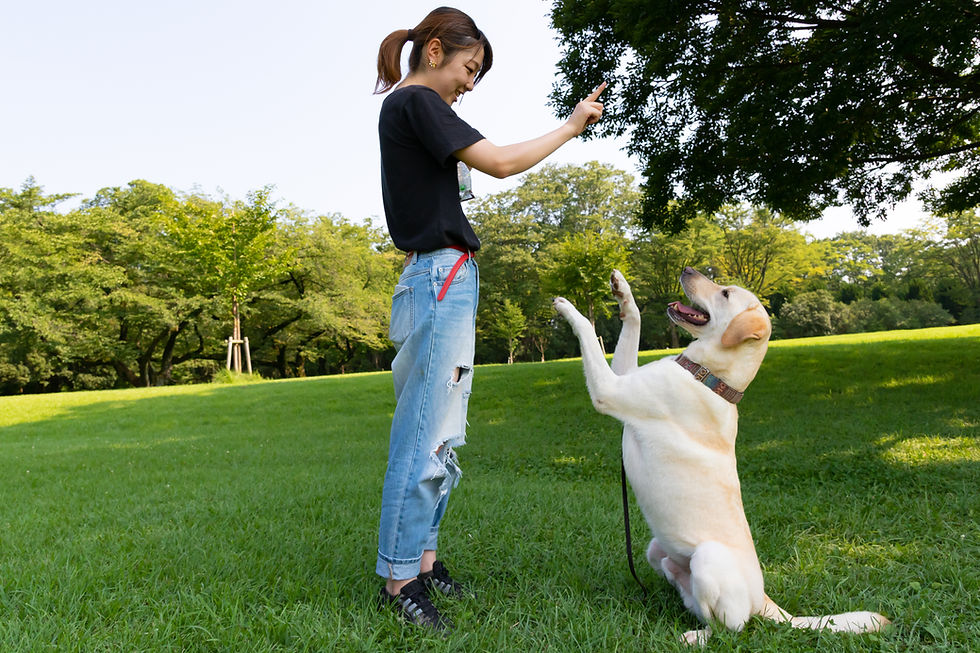Managing a Jumpy Dog
- trainloyalcompanions
- Jan 15
- 4 min read
First, Teach a Reliable Sit
Teaching your dog not to jump is crucial for a well-mannered companion. Jumping on people can be both annoying and potentially dangerous. Regardless of your dog's size, instill a strong, fast, and reliable "sit" command. Practice frequently to reinforce this behavior.
Sit is a proactive and simple solution to many potential behavioral problems. Right from the start, teach your dog canine courtesy by sitting for various activities. Initially, physically lure the sit without verbal commands. Always require and reward the sit behavior for actions like waiting for supper, going outside, receiving treats, and more.
Sit serves as a proactive solution to many potential behavioral problems. Train your dog for an auto-sit during human greetings, both at home and in public. Consistency is key to avoiding confusion, especially when transitioning a young pup into adulthood. For shy dogs, respect their comfort level during greetings. Allow them to sniff and take treats from strangers before introducing the "sit" command gradually.

Here are ten quick steps to help stop a puppy from jumping:
Ignore the Jumping: When your puppy jumps up, avoid giving them attention, eye contact, or physical contact. Turn away and cross your arms to show that jumping is not acceptable behavior.
Use Verbal Cues: Use a firm and consistent verbal cue like "off" or "down" to let your puppy know that jumping is not allowed.
Redirect Behavior: Redirect your puppy's energy by giving them an alternative behavior to focus on, such as sitting or offering a toy to chew on.
Reward Calm Behavior: Praise and reward your puppy when they greet you calmly with all four paws on the ground. Use treats or verbal praise to reinforce this behavior.
Practice Consistency: Enforce consistent rules with all family members and visitors. Everyone should respond the same way when the puppy jumps up to ensure clarity for the puppy.
Use Leash Training: Keep your puppy on a leash when greeting guests or during training sessions. This allows you to control their behavior and prevent jumping.
Teach Sit Command: Teach your puppy to sit on command and use it as an alternative behavior to jumping. Practice the sit command frequently and reward them for complying.
Provide Physical Boundaries: Use physical barriers like baby gates or doors to prevent your puppy from jumping on guests or visitors until they learn appropriate behavior.
Avoid Reinforcing Jumping: Avoid unintentionally reinforcing jumping behavior by not rewarding or encouraging it in any way, even with negative attention.
Be Patient and Consistent: Changing behavior takes time and patience. Stay consistent with training and positive reinforcement, and be patient as your puppy learns to greet people politely without jumping.
Teach Up-Up and Off
For those who desire controlled jumping behavior, train commands like "hugs" or "up-up" for well-trained adult dogs. However, discourage jumping when it's undesired. When your dog jumps up, ignore her by turning away or walking away. Provide attention and rewards only when all four paws are on the floor. Teach your dog that jumping doesn't lead to getting what she wants.
Train your dog the command "off" for furniture interactions. Reward with treats and teach your dog to settle on a mat or bed nearby. Be consistent and avoid confusion with commands like "down" for lying down.
Dealing with Couch Jumping
Prevent couch jumping by managing the environment. Use playpens or baby gates to create safe zones away from the couch. Make the floor enjoyable by teaching a settle on a mat or bed next to the couch. Avoid scolding your puppy for jumping on the couch; instead, guide them off using a long line or leash teether if needed.
Addressing Mouthy and Jumpy Behaviors
Teach your dog to be gentle during play. Use the "Freeze, Be a Tree" technique for biting behavior. Provide tug toys for redirection and praise when your dog stops mouthing. Encourage noncontact play like fetch and tug-of-war instead of rough play with hands. Follow strict rules for tug-of-war to ensure safety. Keep tug toys accessible for redirection when needed.
Teach Your Pup How to Play
Playing is a crucial element in building a strong bond between your dog and your family. It's important to guide your dog in playing gently. Offer a variety of engaging toys and chew items to encourage play with them rather than on your clothing. If your dog tends to bite at your feet and ankles, keep his favorite tug toy in your pocket. When he makes a move, stop moving your feet, present the tug toy, and entice him to grab it. Resume movement when he takes the toy. If the toy isn't available, freeze until your dog stops mouthing, then praise and reward with a toy. Repeat until your dog learns to resist going after your feet.
Promote noncontact play activities like fetch and tug-of-war instead of rough play involving your hands. Teaching tug-of-war helps your dog manage arousal and frustration. Establish strict rules for safe and enjoyable tug-of-war sessions. Once your dog can play tug safely, keep tug toys accessible. If he mouths you, promptly redirect him to the tug toy. Over time, he should learn to seek a toy when the urge to mouth arises.
Managing a jumpy dog requires patience, consistency, and positive reinforcement. By teaching alternative behaviors like sitting and offering controlled jumping commands, you can effectively redirect your dog's energy and foster good manners. Remember to provide plenty of opportunities for noncontact play and offer a variety of toys to keep your dog engaged and stimulated. With dedication and proper training, you can help your furry friend become a well-behaved and happy member of your family. If you encounter any challenges along the way, don't hesitate to seek guidance from a professional dog trainer or behaviorist. Together, you and your dog can enjoy a harmonious and fulfilling relationship built on trust and mutual understanding.



